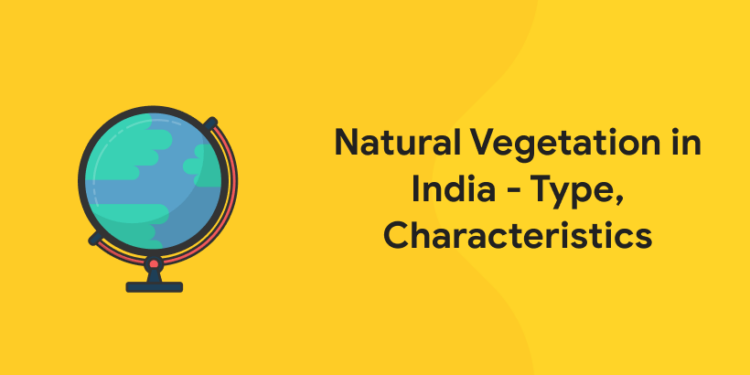Table of Contents
Natural vegetation refers to the plant community that grows naturally without human aid. The natural vegetation which has been left undisturbed for a long time is known as Virgin Vegetation. India is bestowed with a wide range of flora and fauna. The types of natural vegetation differ according to precipitation, soil, climate, and topography. The diverse geographical and climatic condition of India is a major reason for extensive range of natural vegetation in the country. India has 47000 plant species and ranks 10th in the world and fourth in Asia in plant diversity.
Some important features of natural vegetation are:
- The nature of vegetation and the height of the land are strongly intertwined.
- The climate varies as the height rises, and the natural vegetation changes as well.
- Temperature and moisture play a role in plant development.
- It also depends on parameters such as slope and soil thickness.
| Annual Rainfall | Type of Vegetation |
| 200 cm or more | Tropical Evergreen Rain Forests |
| 100 to 200 cm | Monsoon Deciduous Forests |
| 50 to 100 cm | Dry deciduous Forests |
| 25 to 50 cm | Semi Deserts and Deserts |
| Below 25 cm | Desert (Arid) |
Attempt Free Mock Tests for General Knowledge! Download Entri App!
Types of Natural Vegetation in India
- Tropical Evergreen Rainforests
- Deciduous or Monsoon Forests
- Dry Deciduous Forests
- Mountain Forests
- Tidal or Mangrove Forests
- Semi-Desert and Desert Vegetations
Tropical Evergreen Rainforests
This is the most commonly found type of forest in India. These are found in locations with more than 200 cm of annual rainfall and have a temperature of 15 to 30 degrees Celsius. They are dense, multi-layered, and contain many types of flora and fauna. They are very dense that even sunlight cannot reach the ground. The Western Ghats are the primary location of the evergreen forest. They are also largely found in the Northeastern regions of Arunachal Pradesh, Meghalaya, Assam, Nagaland, the Western Ghats, the Tarai areas of the Himalayas, and the Andaman groups of Islands. They are also found in the hills of Khasi and Jaintia.
Trees in evergreen forests reach great heights of up to 60 meters or even above. Due to high heat and high humidity the trees in these woods never lose all of their leaves. All plants struggle upwards for sunlight resulting in a peculiar layer arrangement that looks like a green carpet when viewed from above.. Sisthu, chaplash, rosewood, mahogany, bamboo, garjan, ebony, rubber chinchona and sandalwood are some of the trees.
Attempt General Knowledge Quiz! Register Here!
Deciduous or Monsoon Forests
They are the most widespread forests of India. These are found in places with rainfall ranging from 100 to 200 cm. Deciduous forest are mainly found in on the eastern part of India because of the climatic conditions existing in the region. These forests have a parkland landscape with open stretches in higher rainfall regions of Peninsula. The Deciduous forests are found on the lower slope of the Himalayas, West Bengal, Chhattisgarh, Bihar, Orissa, Karnataka, Maharashtra Jharkhand, and the adjoining areas. The humidity level in these forests lie in the range of 80 to 90% and the average temperature is about 30 degree Celsius.
During the dry winter and summer, trees drop their leaves and they grow back in rainy seasons. The plants here include broad leaved deciduous trees. These forests are comparatively less dense than evergreen forests. On the basis of the availability of water, these forests are further divided into moist and dry deciduous. Teak, sandalwood, deodar, bluegum, ebony, sisam, jackfruit, mahua, palash, arjun, khair, and bamboo form the majority in these areas.
Attempt Free Mock Tests for General Knowledge! Download Entri App!
Dry Deciduous Forests
Dry deciduous forests are mainly located at tropical and subtropical latitudes. These are seen in the areas of the Central Deccan plateau, Punjab, Haryana, parts of Uttar Pradesh, Madhya Pradesh, and South-east of Rajasthan. They occur in climates that are warm, year-round, and may receive several hundred centimeters or rain per year.
Every species in these forests has its own time of leaf casting. The trees here too shed their leaves in dry season. They have a closed but uneven canopy. The forests are composed of a mixture of a few species of deciduous trees rising up to a height of 20 meters. Enough light reaches the ground of these forests to permit the growth of grass and climbers. Dwarf deciduous trees and long-grasses grow in these regions. Most of these areas are used for agriculture. These forests have suffered from over grazing, fire, etc.
Mountain Forests
These are found in mountainous region where the decrease in temperature with increase in altitude leads to the corresponding change in the natural vegetation. Dense forests are common in these areas. They are also known as Alpine Forests. They are common in both the main Himalayan regions as well as the barren cold deserts of the Tran Himalaya. The Indian states, which fall under this region, are Jammu and Kashmir, Himachal Pradesh, Uttarakhand, West Bengal, Sikkim, Arunachal Pradesh, Assam, Meghalaya, Nagaland, Manipur and Mizoram.
Climatic conditions vary from the sub-arctic to arctic, with snow covering the ground for over 5 months a year. The growing season for the plants is thus stunted. These forests have mixed species of broad-leafed evergreen trees and conifers. They also contain scrubs, creepers and ferns. Evergreen trees such as sal, teak, bamboo, and cane grow abundantly in the Himalayas up to an altitude of 1500 meters .Temperate conifer trees such as pine, fir, oak, maple, deodar, laurel, spruce, and cedar grow between 1,500 and 3,500 meters in the mountains. Rhododendrons and junipers grow at greater altitudes in the Himalayas. Alpine meadows occur beyond these plant belts, up to the snowfield.
Attempt General Knowledge Quiz! Register Here!
Tidal or Mangrove Forests
These forests occur near the shore and on the outskirts of deltas, such as the Ganga, Mahanadi, Godavari, Krishna, and Kaveri deltas. They are also known as Littoral Forests. In West Bengal, they are known as ‘Sundarbans’ in West Bengal. Their dense growth depends upon tidal water which submerges the deltaic lands during high tides.
Dense mangroves are the common varieties with roots of the plants submerged under water. Trees in these areas vary in height from 2m to 40m as muddy soil in the environment cannot provide firm support. The woods are thick and there is hardwood in the trees. The trees have supportive roots stilt-like that can suck in oxygen. Plants in these forests include trees, shrubs, ferns, and palms, and these plants are primarily found on river banks and along coastlines in the tropics and sub-tropics. These forests have various trees of low and medium height. The plants are adapted to anaerobic conditions of both salt and fresh water environments. The ‘sundri’ is the most important tree in these area. Apart from that hogla, garan, gewa, golpata, and pasur, and others are found here.
Prepare for General Knowledge Exam! Download Entri App!
Semi-Desert and Desert Vegetations
They are found in locations where rainfall is less than 50 cm. Rajasthan, Gujarat, Punjab, and Karnataka have these type of vegetation.
The plants in these areas have extensive roots and large fleshy stems that store water in order to endure the prolonged drought. The ground plays an important role in the vegetation in Indian semi-deserts and deserts. Many desert plants can only grow if the soil is just the right kind and the right depth. The rocks, cliffs and dry washes usually give shade and protection for plants and animals in desert areas. Thorny shrubs, acacia, babul, and sand binding grasses grow in these areas. Some of the most common trees in this region include cacti, reunjha, khejra, kanju, ak, etc.
The key point to clear an exam lies in methodical and planned preparation. If you are a candidate who wants to pursue your dream career and looking for a good start, Entri App has got it covered for you. Entri App provides a great online platform for all those aspiring to appear for various bank exams, government exams and other competitive exams. Our team of experts provide short and precise video classes which helps in learning the concepts. Users get access to flash cards and quizzes and can attempt unlimited mock exams with the same pattern as that of the real exams. We also provide PDFs of previous years’ question papers with solutions.













